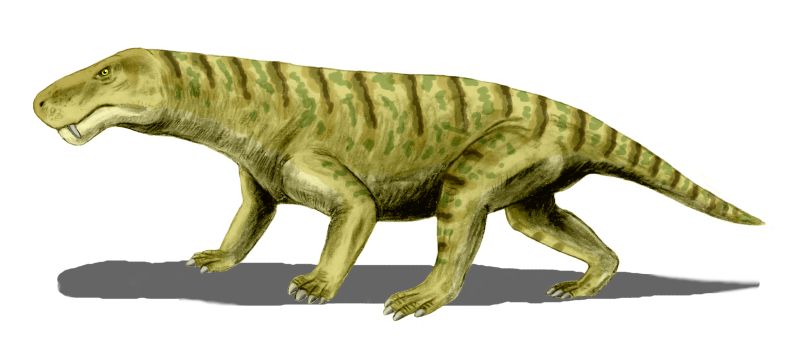Post by stemturtle on Sept 6, 2011 23:58:45 GMT
Gifted member razh00 offers a dozen species of prehistoric amphibians on Shapeways: www.shapeways.com/shops/prehistoric
Extrapolating from 007 of the James Bond movies, we infer that the “double oh” designation for these models is the license to thrill and enchant us. We present these Shapeways models by geological period in group photos with amphibians from other makers. We conclude with comments about the 00 Amphibians classified into 5 categories.
PHOTOS BY GEOLOGICAL PERIOD
Manufacturers are listed after each genus. An asterisk* marks a figure not shown because I do not own it. My collection is roughly by type rather than completeist. Only plastic materials are included. No Cenozoic species. Panosh has no IDs.
00 = Razh00. PV = Play Visions.
DEVONIAN

(Tetrapodomorph) Eusthenopteron by Kaiyodo (1), Starlux*
(Tetrapodomorph) Tiktaalik by 00 (2)
Acanthostega by Kaiyodo (3), Yujin (4)
Ichthyostega by Prehistoric Panorama (5), Sega*, Starlux (6)
CARBONIFEROUS

Coal swamp. Safari might release new trees in 2013.
Crassigyrinus by 00 (1), PV (2)
Diadectes by 00 (3), Panosh* ?, spanned into the Permian.

Eryops by Diener (4), Kaiyodo (5), Panosh ? (6), PV (7), spanned into the Permian.
Limnoscelis by 00 (8), spanned into the Permian.
Ophiderpeton by 00 (9)
Pholiderpeton (= Eogyrinus) by PV (10)
PERMIAN

Cacops (= Labyrinthodont) by Starlux (1). Fossil leaves of seed fern Glossopteris.
Diplocaulus by Aurora*, Kaiyodo (2), PV (3), Prehistoric Panorama (4), Starlux (5)

Gerobatrachus by 00 (6)
Pantylus by 00 (7)
Peltobatrachus by PV (8)
Platyhystrix by PV (9)
Prionosuchus by 00 (10)
Seymouria by 00 (11), Panosh* ?, TimMee (12)
TRIASSIC

Deltasaurus by Yowie (1)
Gerrothorax by PV (2)
Mastondonsaurus by Bullyland (3), Starlux (4)
Metoposaurus by 00 (5)
Promastodonsaurus by Dawn of the Dinosaurs (6)
Triadobatrachus by PV (7)
JURASSIC & CRETACEOUS

Eocaecilia by 00 (1)
Karaurus larval stage by 00 (2), adult by 00 (3)
Siderops by Yowie (4)
&
Koolasuchus by 00 (5). Cretaceous chalk is from Kansas.
TAXONOMY
Below, the 00 Amphibians exemplify these 5 groups: Stem-Tetrapods, Temnospondyli, Lissamphibia, Reptilomorpha, and Lepospondyli. Each category ends with a summary of kindred genera from all manufacturers, as recorded above for the photos.
Originally, anamniotic tetrapods were divided into Labyrinthodontia, based on tooth structure, and Lepospondyli, for spool-shaped vertebrae. Discarding the obsolete term labyrithodont, we subsitute 3 groups: Stem-Tetrapods, Temnospondyli, and Reptilomorpha. An additional division, Lissamphibia, which includes living amphibians, probably evolved from the temnospondyls. Controversial hypotheses complicate the phylogeny for amphibians.
STEM-TETRAPODS may include tetrapodomorphs, which are 4-legged fish, ichthyostegalians, and primitive tetrapods. 375 MYA, Tiktaalik had traits of both fish and amphibians. Dar-winning. The discovery of tetrapod footprints in Poland challenged Tiktaalik’s fame as a transitional fossil. The trackway is dated 20 MY older, possibly relegating this sarcopterygian to relic status, but still anatomically enlightening. Crassigyrinus can be regarded as an early tetrapod that reverted to a fully aquatic niche.
Genera: Eusthenopteron, Tiktaalik, Acanthostega, Ichthyostega, Crassigyrinus.
TEMNOSPONDYLI is an enormous order that comprises the majority of Paleozoic and Mesozoic amphibians. In 2008 the press celebrated Gerobatrachus as a missing link to modern amphibians. At 10 meters, Prionosuchus was the largest amphibian known. Metoposaurus was gator size, as was typical, safe in the swamps from most predators. Living where it was too cold for competitors, Koolasuchus was one of the last surviving temnospondyls.
Genera: Eryops, Gerobatrachus, Platyhystrix, Cacops, Prionosuchus, Promastodonsaurus, Mastondonsaurus, Peltobatrachus, Deltasaurus, Gerrothorax, Metoposaurus, Siderops, Koolasuchus.
LISSAMPHIBIA features the orders Salientia, Caudata, and Gymnophiona: frogs, salamanders, and caecilians. The origin of lissamphibians is debated. The amphibamid Gerobatrachus shared traits with both frogs and salamanders. Most researchers consider Lissamphibia monophyletic, but some favor a lepospondyl origin for caecilians. No resolution of this puzzle is imminent. Karaurus was an early salamander. Eocaecilia was a caecilian that still had tiny legs.
Genera: Triadobatrachus, Karaurus, Eocaecilia.
REPTILOMORPHA and Antracosauria are terms used synonymously by some paleontologists. Despite the tendency toward terrestrial adaptations, an aquatic larval stage was likely required. Examples are Limnoscelis, Diadectes, and Seymouria. Diadectormorphs shared characteristics with the cotylosaur progenitor of all the amniotes, from Hylonomus through Homo.
Genera: Pholiderpeton (= Eogyrinus), Limnoscelis, Diadectes, Seymouria.
LEPOSPONDYLI, a sister group to Reptilomorpha, tended to be small. Two of the orders are Microsauria, represented by Pantylus, and Aïstopoda, with the snake-like Ophiderpeton. Lepospondyls have been proposed as ancestors of modern amphibians and of amniotes, but many of the shared traits may be due to small size. The fossil record is too incomplete to resolve the origins mystery.
Genera: Pantylus, Diplocaulus, Ophiderpeton.
Members are encouraged to report additional figures. Thanks to Mrs. stemturtle for her expertise with Photoshop. The next time a new model is released, we will be stirred, not shaken.
LINKS:
Some of the missing images can seen at Randy Knol’s Dinosaur Collector Site:
www.dinosaurcollector.150m.com/carboniferous.html
For the Aurora Diplocaulus, see “my collection” by ichthyostega:
dinotoyforum.proboards.com/index.cgi?board=collections&action=display&thread=4438
Panosh photos from sbell are in “My Prehistoric Amphibian collection!” by bokisaurus:
dinotoyforum.proboards.com/index.cgi?board=collections&action=display&thread=1054&page=1
Extrapolating from 007 of the James Bond movies, we infer that the “double oh” designation for these models is the license to thrill and enchant us. We present these Shapeways models by geological period in group photos with amphibians from other makers. We conclude with comments about the 00 Amphibians classified into 5 categories.
PHOTOS BY GEOLOGICAL PERIOD
Manufacturers are listed after each genus. An asterisk* marks a figure not shown because I do not own it. My collection is roughly by type rather than completeist. Only plastic materials are included. No Cenozoic species. Panosh has no IDs.
00 = Razh00. PV = Play Visions.
DEVONIAN

(Tetrapodomorph) Eusthenopteron by Kaiyodo (1), Starlux*
(Tetrapodomorph) Tiktaalik by 00 (2)
Acanthostega by Kaiyodo (3), Yujin (4)
Ichthyostega by Prehistoric Panorama (5), Sega*, Starlux (6)
CARBONIFEROUS

Coal swamp. Safari might release new trees in 2013.
Crassigyrinus by 00 (1), PV (2)
Diadectes by 00 (3), Panosh* ?, spanned into the Permian.

Eryops by Diener (4), Kaiyodo (5), Panosh ? (6), PV (7), spanned into the Permian.
Limnoscelis by 00 (8), spanned into the Permian.
Ophiderpeton by 00 (9)
Pholiderpeton (= Eogyrinus) by PV (10)
PERMIAN

Cacops (= Labyrinthodont) by Starlux (1). Fossil leaves of seed fern Glossopteris.
Diplocaulus by Aurora*, Kaiyodo (2), PV (3), Prehistoric Panorama (4), Starlux (5)

Gerobatrachus by 00 (6)
Pantylus by 00 (7)
Peltobatrachus by PV (8)
Platyhystrix by PV (9)
Prionosuchus by 00 (10)
Seymouria by 00 (11), Panosh* ?, TimMee (12)
TRIASSIC

Deltasaurus by Yowie (1)
Gerrothorax by PV (2)
Mastondonsaurus by Bullyland (3), Starlux (4)
Metoposaurus by 00 (5)
Promastodonsaurus by Dawn of the Dinosaurs (6)
Triadobatrachus by PV (7)
JURASSIC & CRETACEOUS

Eocaecilia by 00 (1)
Karaurus larval stage by 00 (2), adult by 00 (3)
Siderops by Yowie (4)
&
Koolasuchus by 00 (5). Cretaceous chalk is from Kansas.
TAXONOMY
Below, the 00 Amphibians exemplify these 5 groups: Stem-Tetrapods, Temnospondyli, Lissamphibia, Reptilomorpha, and Lepospondyli. Each category ends with a summary of kindred genera from all manufacturers, as recorded above for the photos.
Originally, anamniotic tetrapods were divided into Labyrinthodontia, based on tooth structure, and Lepospondyli, for spool-shaped vertebrae. Discarding the obsolete term labyrithodont, we subsitute 3 groups: Stem-Tetrapods, Temnospondyli, and Reptilomorpha. An additional division, Lissamphibia, which includes living amphibians, probably evolved from the temnospondyls. Controversial hypotheses complicate the phylogeny for amphibians.
STEM-TETRAPODS may include tetrapodomorphs, which are 4-legged fish, ichthyostegalians, and primitive tetrapods. 375 MYA, Tiktaalik had traits of both fish and amphibians. Dar-winning. The discovery of tetrapod footprints in Poland challenged Tiktaalik’s fame as a transitional fossil. The trackway is dated 20 MY older, possibly relegating this sarcopterygian to relic status, but still anatomically enlightening. Crassigyrinus can be regarded as an early tetrapod that reverted to a fully aquatic niche.
Genera: Eusthenopteron, Tiktaalik, Acanthostega, Ichthyostega, Crassigyrinus.
TEMNOSPONDYLI is an enormous order that comprises the majority of Paleozoic and Mesozoic amphibians. In 2008 the press celebrated Gerobatrachus as a missing link to modern amphibians. At 10 meters, Prionosuchus was the largest amphibian known. Metoposaurus was gator size, as was typical, safe in the swamps from most predators. Living where it was too cold for competitors, Koolasuchus was one of the last surviving temnospondyls.
Genera: Eryops, Gerobatrachus, Platyhystrix, Cacops, Prionosuchus, Promastodonsaurus, Mastondonsaurus, Peltobatrachus, Deltasaurus, Gerrothorax, Metoposaurus, Siderops, Koolasuchus.
LISSAMPHIBIA features the orders Salientia, Caudata, and Gymnophiona: frogs, salamanders, and caecilians. The origin of lissamphibians is debated. The amphibamid Gerobatrachus shared traits with both frogs and salamanders. Most researchers consider Lissamphibia monophyletic, but some favor a lepospondyl origin for caecilians. No resolution of this puzzle is imminent. Karaurus was an early salamander. Eocaecilia was a caecilian that still had tiny legs.
Genera: Triadobatrachus, Karaurus, Eocaecilia.
REPTILOMORPHA and Antracosauria are terms used synonymously by some paleontologists. Despite the tendency toward terrestrial adaptations, an aquatic larval stage was likely required. Examples are Limnoscelis, Diadectes, and Seymouria. Diadectormorphs shared characteristics with the cotylosaur progenitor of all the amniotes, from Hylonomus through Homo.
Genera: Pholiderpeton (= Eogyrinus), Limnoscelis, Diadectes, Seymouria.
LEPOSPONDYLI, a sister group to Reptilomorpha, tended to be small. Two of the orders are Microsauria, represented by Pantylus, and Aïstopoda, with the snake-like Ophiderpeton. Lepospondyls have been proposed as ancestors of modern amphibians and of amniotes, but many of the shared traits may be due to small size. The fossil record is too incomplete to resolve the origins mystery.
Genera: Pantylus, Diplocaulus, Ophiderpeton.
Members are encouraged to report additional figures. Thanks to Mrs. stemturtle for her expertise with Photoshop. The next time a new model is released, we will be stirred, not shaken.
LINKS:
Some of the missing images can seen at Randy Knol’s Dinosaur Collector Site:
www.dinosaurcollector.150m.com/carboniferous.html
For the Aurora Diplocaulus, see “my collection” by ichthyostega:
dinotoyforum.proboards.com/index.cgi?board=collections&action=display&thread=4438
Panosh photos from sbell are in “My Prehistoric Amphibian collection!” by bokisaurus:
dinotoyforum.proboards.com/index.cgi?board=collections&action=display&thread=1054&page=1







 Thanks for bringing it to my attention, especially since their location is Winona, MN, I believe. No articles in PT.
Thanks for bringing it to my attention, especially since their location is Winona, MN, I believe. No articles in PT.




